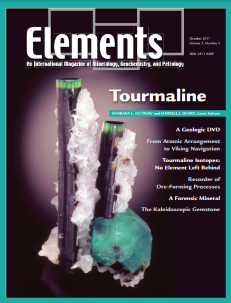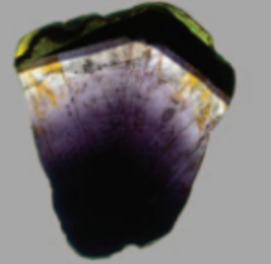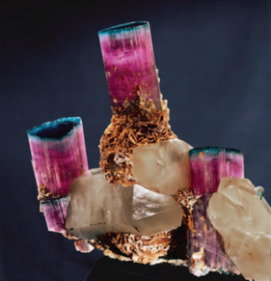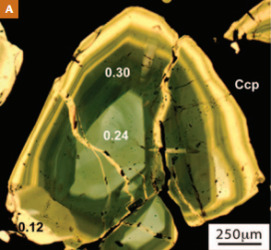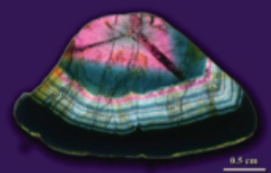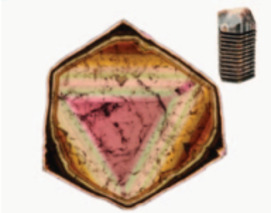
Tourmaline
Barbara L. Dutrow and Darrell J. Henry – Guest Editors
Table of Contents
From the Vikings’ sunstone to a modern piezometric pressure sensor, tourmaline is an intriguing mineral with a new degree of significance. Tourmaline was considered by 18th century physicists as the key to a grand unification theory relating heat, electricity, and magnetism, but new studies define its role as an indi cator of Earth’s processes. With its plethora of chem ical constituents and its wide stability range, from near surface conditions to the pressures and tem peratures of the mantle, tourmaline has become a valuable mineral for under standing crustal evolution. Tourmaline encapsulates a single mineral thermom eter, a provenance indicator, a fluid composition recorder, and a geochronometer. Although also prized as a gemstone, tourmaline is clearly more than meets the eye.
- Tourmaline: A Geologic DVD
- Tourmaline the Indicator Mineral: From Atomic Arrangement to Viking Navigation
- Tourmaline Isotopes: No Element Left Behind
- Tourmaline as a Recorder of Ore-Forming Processes
- Tourmaline as a Petrologic Forensic Mineral: A Unique Recorder of Its Geologic Past
- Tourmaline: The Kaleidoscopic Gemstone
AHF Analysentechnik
The Arkenstone
Australian Scientific Instruments (ASI)
Bruker
CAMECA
CrystalMaker Software
Crystal Classics
Excalibur Mineral Corporation
FEI
Gemological Institute of America
GRS GemResearch SwissLab AG
Kristalle
Leonard Himes Fine Minerals
RockWare
Savillex
SPECTRO
v7n6 MINE WASTES
Guest Editors: Karen Hudson-Edwards (Birbeck College, University of London), Heather E. Jamieson (Queen’s University), and Bernd Lottermoser (University of Tasmania)
Since the dawn of civilization, humankind has been extracting metals and minerals for the production of goods, energy, and building materials. These mining activities have created great wealth, but they have also produced colossal quantities of solid and liquid wastes, known collectively as “mine wastes.” Mine wastes represent the greatest proportion of waste produced by industrial activity. In fact, the quantity of solid mine wastes and the quantity of Earth materials moved by fundamental global geological processes are of the same order of magnitude—approximately sev eral thousand million tons per year. Therefore, the large scale production, secure disposal, and sustainable remediation of mine wastes represent problems of global significance. Over the past 10–15 years, novel geochemical, mineralogical, micro biological and toxicological techniques have led to a much better understanding of the character, weathering mechanisms, long term stability, ecotoxicology, and remediation of mine wastes. This issue of Elements will bring readers up to date with these current findings and will highlight new frontiers for mine waste research.
- Mine Wastes: Past, Present, Future Karen A. Hudson-Edwards (University of Exeter), Heather E. Jamieson (Queen’s University), and Bernd G. Lottermoser (James Cook University)
- Geochemistry and Mineralogy of Solid Mine Waste: Essential Knowledge for Predicting Environmental Impact Heather E. Jamieson (Queen’s University)
- Waste Streams of Mined Oil Sands: Characteristics and Remediation Kim L. Kasperski (Natural Resources Canada) and Randy J. Mikula (Natural Resources Canada)
- Mine Waters: Acidic to Circumneutral D. Kirk Nordstrom (U.S. Geological Survey)
- Mine Wastes and Human Health Geoffrey S. Plumlee (U.S. Geological Survey) and Suzette A. Morman (U.S. Geological Survey)
- Recycling, Reuse and Rehabilitation of Mine Wastes Bernd G. Lottermoser (James Cook University) and Graeme Spiers (Laurentian University)
- Cosmochemistry (February 2011)
- Iron in Earth Surface Systems (April 2011)
- Global Water Sustainability (June 2011)
- When the Continental Crust Melts (August 2011)
- Tourmaline (October 2011)
- Mine Wastes (December 2011)
Download 2012 Thematic Preview


